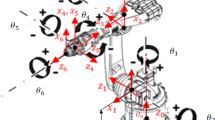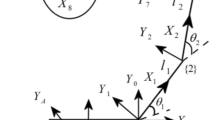Abstract
In this study, the solution of inverse kinematics, which is the most fundamental problem in the field of robotics, is handled with the grey wolf optimization algorithm. Grey wolves belong to the Canis Lupus species and they act in a number of organization and cooperation while hunting in swarm in nature. Thanks to this heuristic technique, which was created by transferring this collaboration first to the algorithm and then to the code, many engineering problems were quickly solved. Similarly, in this study, inverse kinematics solution, which is an engineering problem, was solved with the grey wolf swarm optimization technique. The results are given in comparison with the traditional grey wolf algorithm and the modified grey wolf algorithm obtained by improving one of the control parameters of this algorithm and with other swarm-based algorithms. According to these results, it has been clearly observed that the grey wolf algorithm produces similar results with other swarm-based algorithms, but the modified grey wolf algorithm produces better values. This shows that the grey wolf optimization algorithm can achieve much better convergence by modifying or strengthening it.














Similar content being viewed by others
Explore related subjects
Discover the latest articles and news from researchers in related subjects, suggested using machine learning.References
Yang XS (2014) Swarm intelligence based algorithms: a critical analysis. Evol Intel 7:17–28
Dorigo M, Maniezzo V, Colorni A (1991) Distributed optimization by ant colonies. In: European conference on artificial life, vol 134, p 142
Kennedy J, Eberhart R (1995) Particle swarm optimization. In: International conference on neural networks, pp 1942–1948
Karaboga D, Basturk B (2008) On the performance of artificial bee colony (ABC) algorithm. Appl Soft Comput 8:687–697
Yang XS (2013) Multiobjective firefly algorithm for continuous optimization. Eng Comput 29:175–184
Ribeiro JM, et al (2017) Comparison of PID controller tuning methods: analytical/classical techniques versus optimization algorithms. In: IEEE 18th international Carpathian control conference (ICCC), pp 533–538
Doma MI (2013) Particle swarm optimization in comparison with classical optimization for GPS network design. J Geod Sci 3:250–257
Yang XS, Deb S (2014) Cuckoo search: recent advances and applications. Neural Comput Appl 24(1):169–174
Iakovlev R, Denisov A, Prakapovich R (2020) Iterative method for solving the inverse kinematics problem of multi-link robotic systems with rotational joints. In: International conference on electromechanics and robotics, pp 237–251
Dereli S, Köker R (2020) A meta-heuristic proposal for inverse kinematics solution of 7-DOF serial robotic manipulator: quantum behaved particle swarm algorithm. Artif Intell Rev 53:949–964
Ren H, Ben-Tzvi P (2020) Learning inverse kinematics and dynamics of a robotic manipulator using generative adversarial networks. Robot Autonom Syst 124:1
Bai L et al (2019) Appl Sci 9:546
Rajaa R, Dutta A, Dasgupta B (2019) Learning framework for inverse kinematics of a highly redundant mobile manipulator. Robot Autonom Syst 120:103245. https://doi.org/10.1016/j.robot.2019.07.015
Toz M (2020) Chaos-based Vortex Search algorithm for solving inverse kinematics problem of serial robot manipulators with offset wrist. Appl Soft Comput 89:106074. https://doi.org/10.1016/j.asoc.2020.106074
Ram RV, Pathak PM, Junco SJ (2019) Inverse kinematics of mobile manipulator using bidirectional particle swarm optimization by manipulator decoupling. Mech Mach Theory 131:385–405
Dereli S, Köker R (2020) Simulation based calculation of the inverse kinematics solution of 7-DOF robot manipulator using artificial bee colony algorithm. SN Appl Sci 2(1):1–11
Dereli S, Köker R (2020) Calculation of the inverse kinematics solution of the 7-DOF redundant robot manipulator by the firefly algorithm and statistical analysis of the results in terms of speed and accuracy. Inverse Problem Sci Eng 28:601–613
Zhang L, Xiao N (2019) A novel artificial bee colony algorithm for inverse kinematics calculation of 7-DOF serial manipulators. Soft Comput 23:3269–3277
El-Sherbiny A, Elhosseini MA, Haikal AY (2018) A new ABC variant for solving inverse kinematics problem in 5 DOF robot arm. Appl Soft Comput 73:24–38
Pérez L et al (2019) Industrial robot control and operator training using virtual reality interfaces. Comput Ind 109:114–120
Liu H, Wang L (2020) Remote human–robot collaboration: a CYBEr–physical system application for hazard manufacturing environment. J Manuf Syst 54:24–34
Iliukhin VN et al (2017) The modeling of inverse kinematics for 5 DOF manipulator. Proc Eng 176:498–505
Su H et al (2018) Safety-enhanced collaborative framework for tele-operated minimally invasive surgery using a 7-DoF torque-controlled robot. Int J Control Autom Syst 16:2915–2923
Chen X, Zhao B, Wang Y, Xu S, Gao X (2018) Control of a 7-DOF robotic arm system with an SSVEP-based BCI. Int Neural J Syst 28(08):1850018. https://doi.org/10.1142/S0129065718500181
Köker R, Çakar T (2016) A neuro-genetic-simulated annealing approach to the inverse kinematics solution of robots: a simulation based study. Eng Comput 32:553–565
Patil A, Kulkarni M, Aswale A (2017) Analysis of the inverse kinematics for 5 DOF robot arm using DH parameters. In: IEEE international conference on real-time computing and robotics (RCAR), pp 688–693
Singh S, Singla E (2016) Realization of task-based designs involving DH parameters: a modular approach. Intel Serv Robot 9:289–296
Dereli S, Köker R (2018) IW-PSO approach to the inverse kinematics problem solution of a 7-DOF serial robot manipulator. Sigma J Eng Nat Sci 36:77–85
Edla DR, Kongara MC, Cheruku R (2019) A PSO based routing with novel fitness function for improving lifetime of WSNs. Wireless Pers Commun 104:73–89
Malhotra R, Khanna M (2019) Dynamic selection of fitness function for software change prediction using particle swarm optimization. Inf Softw Technol 112:51–67
de Souza EF, Goues CL, Camilo-Junior CG (2018) A novel fitness function for automated program repair based on source code checkpoints. Genet Evolution Comput Confer 2018:1443–1450
Greche L, et al (2017) Comparison between Euclidean and Manhattan distance measure for facial expressions classification. In: International conference on wireless technologies, embedded and intelligent systems (WITS), pp 1–4
Mirjalili S, Mirjalili SM, Lewis A (2014) Grey wolf optimizer. Adv Eng Softw 69:46–61
Ozsoydan FB (2019) Effects of dominant wolves in grey wolf optimization algorithm. Appl Soft Comput 83:105658. https://doi.org/10.1016/j.asoc.2019.105658
Al-Tashi Q, Kadir SJA, Rais HM, Mirjalili S, Alhussian H (2019) Binary optimization using hybrid grey wolf optimization for feature selection. IEEE Access 7:39496–39508. https://doi.org/10.1109/ACCESS.2019.2906757
Ibrahim RA, Elaziz MA, Lu S (2018) Chaotic opposition-based grey-wolf optimization algorithm based on differential evolution and disruption operator for global optimization. Expert Syst Appl 108:1–27
Niu P, Niu S, Chang L (2019) The defect of the Grey Wolf optimization algorithm and its verification method. Knowl-Based Syst 171:37–43
Faris H et al (2018) Grey wolf optimizer: a review of recent variants and applications. Neural Comput Appl 30:413–435
Gu Q, Li X, Jiang S (2019) Hybrid genetic grey wolf algorithm for large-scale global optimization. Complexity
Sharma P et al (2019) Diagnosis of Parkinson’s disease using modified grey wolf optimization. Cogn Syst Res 54:100–115
Pradhan M, Roy PK, Pal T (2018) Oppositional based grey wolf optimization algorithm for economic dispatch problem of power system. Ain Shams Eng J 9:2015–2025
Natesan G, Chokkalingam A (2019) Task scheduling in heterogeneous cloud environment using mean grey wolf optimization algorithm. ICT Express 5:110–114
Khandelwal A et al (2018) Modified grey wolf optimization algorithm for transmission network expansion planning problem. Arab J Sci Eng 43:2899–2908
Kalemci EN et al (2020) Design of reinforced concrete cantilever retaining wall using Grey wolf optimization algorithm. Structures 23:245–253
Rahmani M, Komijani H, Rahman MH (2020) New sliding mode control of 2-DOF robot manipulator based on extended grey wolf optimizer. Int J Control Autom Syst 2020:1–9
Rao AM, Ramji K, Kumar TN (2018) Intelligent navigation of mobile robot using grey wolf colony optimization. Mater Today: Proc 5:19116–19125
Zhou Z et al (2018) Color difference classification based on optimization support vector machine of improved grey wolf algorithm. Optik 170:17–29
Long W et al (2017) A modified augmented Lagrangian with improved grey wolf optimization to constrained optimization problems. Neural Comput Appl 28:421–438
Nadimi-Shahraki MH, Taghian S, Mirjalili S (2021) An improved grey wolf optimizer for solving engineering problems. Expert Systems with Applications 166:113917. https://doi.org/10.1016/j.eswa.2020.113917
Gao ZM, Zhao J (2019) An improved grey wolf optimization algorithm with variable weights. Comput Intell Neurosci 2019:2981282. https://doi.org/10.1155/2019/2981282
Heidari AA, Pahlavani P (2017) An efficient modified grey wolf optimizer with Lévy flight for optimization tasks. Appl Soft Comput 60:115–134
Sun J, Feng B, Xu W (2004) Particle swarm optimization with particles having quantum behavior. In: Proceedings of the congress on evolutionary computation
Mirjalili S, Lewis A (2016) The whale optimization algorithm. Adv Eng Softw 62:51–67
Karaboga D, Basturk B (2008) On the performance of artificial bee colony (ABC) algorithm. Appl Soft Comput 5:687–697
Author information
Authors and Affiliations
Corresponding author
Ethics declarations
Conflict of Interest
The authors declare that there is no conflict of interests regarding the publication of this paper.
Additional information
Publisher's Note
Springer Nature remains neutral with regard to jurisdictional claims in published maps and institutional affiliations.
Rights and permissions
About this article
Cite this article
Dereli, S. A new modified grey wolf optimization algorithm proposal for a fundamental engineering problem in robotics. Neural Comput & Applic 33, 14119–14131 (2021). https://doi.org/10.1007/s00521-021-06050-2
Received:
Accepted:
Published:
Issue Date:
DOI: https://doi.org/10.1007/s00521-021-06050-2




